How to Choose the Right E-commerce Platform for Your Online Store?
When choosing a platform, ensure it fits your business size and technical know-how. You want something that scales as you grow and gives you the customization you need. If you're not a tech expert, ease of use and solid support are essential.
Keep an eye on costs—monthly fees, transaction charges, and extras like hosting and plugins can add up fast. Look for built-in features like SEO tools, multichannel selling, and analytics to keep your business running smoothly and visible online.
And don't forget—your platform should support your favorite payment options and offer top-notch security for your customers. A perfect eCommerce website builder ensures all these facilities. Here is a quick view of the best e-commerce website builders in our eyes.
WooCommerce- Best For WordPress-based Websites with complete freedom of flexibility. (small to large-sized e-commerce site) Shopify- Best for an All-in-one e-commerce Website. Wix- Best for creative control and customization Squarespace- Best for creatives and profesionals Bigcommerce- Best for medium to large stores
Shopify And WooCommerce: Quick Overview
Shopify and WooCommerce are the top two e-commerce builders worldwide. Through extensive research, we have found that in 2024, there are 8,401,332 websites belonging to Shopify customers. Among these, 5,460,808 websites are currently live and actively using Shopify, while 2,940,524 websites have used Shopify in the past.
Additionally, we have data on 8,010,495 websites using WooCommerce Checkout. Of these, 3,416,935 websites are live and use WooCommerce Checkout, and 4,593,560 websites have used WooCommerce in the past. Remember that these two are mostly used website builders for e-commerce stores.
The diagram shows the Usage Statistics between WooCommerce And Shopify.

Shopify: All-in-one E-commerce Software Platform
What Is Shopify?
Shopify is a widely used e-commerce platform known for its user-friendly design. As of September 2024, Shopify is responsible for powering 30,745 websites, comprising 3.07% of the top 1 million e-commerce sites. [Source:builtwith] It's an excellent choice for those solely focused on e-commerce, offering an all-in-one website-building solution that's easy to use. This platform is well-suited for small to medium-sized business owners looking to create a professional online store without dealing with technical complexities. While its convenience comes at a cost, you can try out Shopify for three days at no charge before making any commitments.
Pros of Shopify (Why It’s Perfect for You):
- You'll find Shopify incredibly easy to use, even if you're starting with e-commerce.
- You don't have to worry about hosting or security—it's all taken care of for you.
- With many apps and plugins, you can easily add new features to your store as you grow.
- Shopify's 24/7 customer support has your back whenever you face an issue, so you're never alone.
Cons of Shopify (What You Should Know):
- You might notice higher transaction fees than other platforms, impacting your profits.
- If you love customization, Shopify's options are limited, so you may feel restricted when tailoring your store.
- You'll depend on Shopify's ecosystem, which means you're tied to their tools and apps.
Five e-commerce websites in the United States have very high traffic using Shopify
[
- Slate Group
- Star Tribune
- Vogue
- Streamlabs
- Shop Justice](link)
WooCommerce: Best for WordPress-based Website
What Is WooCommerce?
WooCommerce is an open-source plugin for WordPress that can turn any WordPress site into a robust eCommerce store. As of September 2024, it powers 18,540 websites, equivalent to 1.85% of the top 1 million eCommerce sites. [Source:builtwith] Although Shopify is the more popular choice, in 2024, WooCommerce will be preferred by those who desire complete control and customization over their online store. Thanks to its open-source nature, WooCommerce enables users to adjust and modify every aspect of their store's design and functionality. While WooCommerce is free, users are responsible for their hosting and security. It makes WooCommerce an ideal platform for individuals who value flexibility and are willing to invest extra effort to create a store that aligns perfectly with their vision.
Pros of WooCommerce (Why You’ll Love It):
- WooCommerce is free and open-source; you can build your store without upfront costs.
- Most plugins are one-time payments, meaning you avoid ongoing subscription fees.
- You'll have complete control and flexibility to design and customize every aspect of your store exactly how you want it.
- No transaction fees—you can choose whichever payment gateway works best, keeping more of your profits.
Cons of WooCommerce (Things to Watch Out For):
- You'll need to host the website, which means finding and managing your hosting service.
- If you're not tech-savvy, You may feel overwhelmed when setting up and managing WooCommerce.
- Unlike Shopify, support is limited, so you must rely on online resources or handle issues independently.
- Security is your responsibility, so if something goes wrong, you must fix it.
Five e-commerce websites in the United States have high traffic using WooCommerce Checkout.
- PayPal Holdings
- GoComics
- Mayo Foundation
- Michelin North America Inc
- The MGA Shop](link)
Understanding the features of each platform can make a big difference to the success of your online business. This detailed comparison helps you find the perfect option for your e-commerce store, so you can make a knowledgeable decision that aligns with your business objectives.
Shopify vs WooCommerce: Detailed Comparison
Both platforms are powerful e-commerce builders and fierce competitors, each with its own set of unique features. Choosing between them can be challenging, and the best decision depends on your specific needs, skills, budget, and time constraints.
Here we highlight the key points where they differ in detail for your better understanding.
Which is Easier for You: Shopify or WooCommerce?
Shopify is undoubtedly the clear winner for ease of use. Its all-in-one platform takes care of everything, letting you focus on selling. On the other hand, WooCommerce provides extensive customization and control but requires a more complex setup.
Shopify: The Winner For Easier Setup

Shopify is designed for ease of use, especially for beginners who want a quick and straightforward way to get their online store up and running. From the moment you sign up, Shopify guides you through the setup process, encouraging you to add products before choosing a template. This is ideal if you want to focus on making sales right away.
Shopify's dashboard is intuitive, and even bulk product uploads via CSV are simple. Plus, hosting, SSL certificates, and security are all included, so you don't have to worry about the technical details. Shopify also integrates AI features, like product description generators, that make your store look polished without extra effort.
WooCommerce: Requires A More Complex Setup

WooCommerce is known for its robust customization capabilities, but it does require a higher level of technical expertise and time commitment, particularly for those starting from scratch.
It seamlessly integrates with WordPress, making it an excellent option for users familiar with the platform, although beginners may face more significant initial challenges. Setting up hosting and domains and managing security are all tasks that users must handle on their own(sometimes hosting provider companies do it for you). Once the WordPress setup is complete, you must download the WooCommerce plugin.
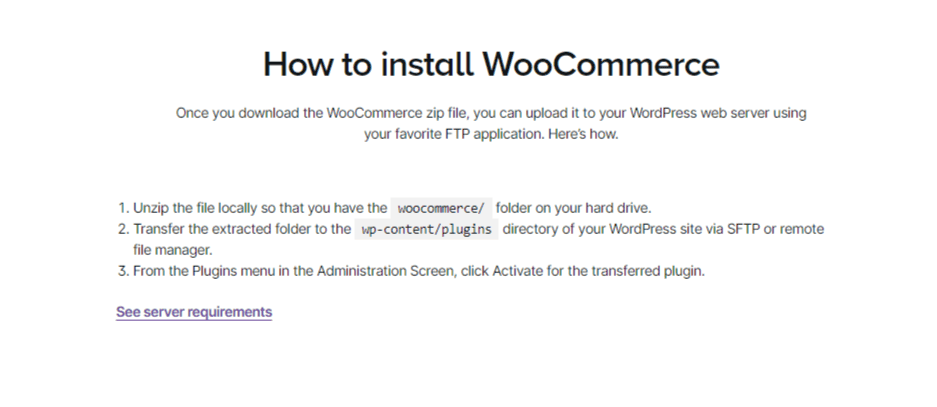
Once the download is complete, acquiring WooCommerce involves:
- Unzipping the plugin file
- Uploading it to the WordPress wp-content/plugins/ directory via SFTP or remote file manager
- Activating it from the WordPress dashboard
- This process can be daunting for non-technical users.
Final Comparison for Easy Setup: Shopify Vs WooCommerce
If you want to get started quickly with minimal hassle, Shopify is the clear winner for ease of use. Go to their website, click "sign up," and start creating. Everything will appear in front of you. You need not worry about hosting or security; Shopify will handle everything.
On the other hand, WooCommerce offers far more customization and control but at the cost of a more involved setup. Choose WooCommerce if you're comfortable with WordPress, want maximum flexibility, and don't mind dealing with learning curves.
Who Costs More: Shopify vs WooCommerce?
Shopify has higher costs, although it offers a 3-day trial and a $1 first-month offer. Its prices range from $29/month for the Basic plan to $299/month for the Advanced plan, which might be considered expensive. Again, monthly charges for Shopify sites with non-standard features can add up. Even if you don't have competitive processing rates, you still have to share some processing fees with Shopify, which is undesirable! WooCommerce is a free WordPress plugin that requires hosting expenses, domain registration, and plugins and themes. Your costs increase as you add tools and features, giving you complete control over your expenses. You do not need to pay any transaction fees here.
Shopify Pricing: Choose the Plan That Fits You
Shopify has a plan for every stage of your business journey. Let's break it down so you can easily find the one right for you!
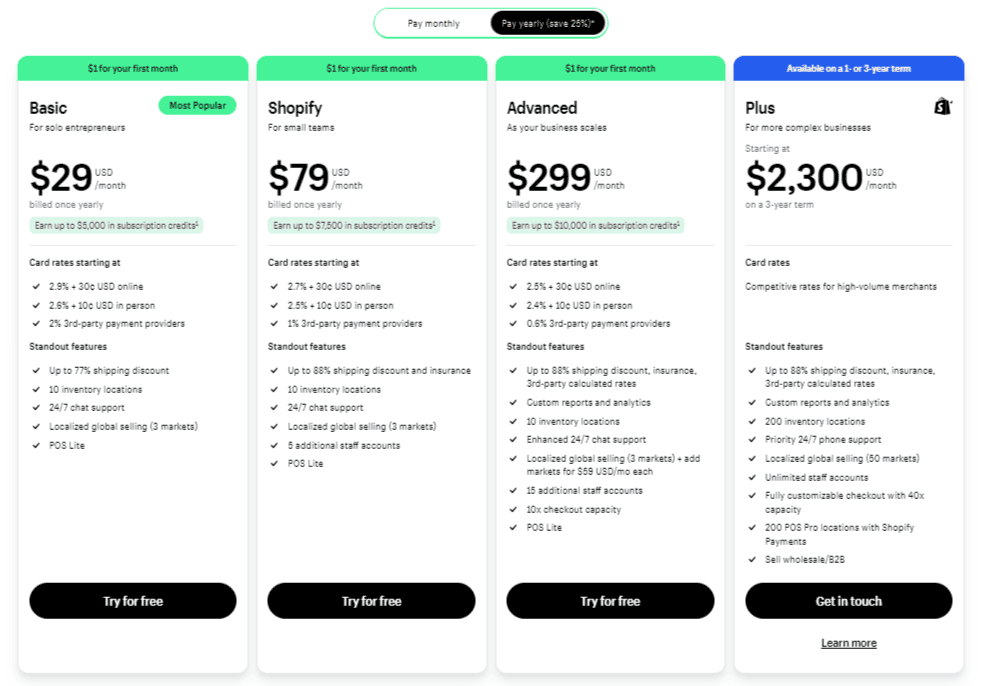
Basic Shopify – Start Strong as a Solo Entrepreneur If you're just getting started and need an affordable option to kick off your store, it is the plan for you.
Price: $29/month (billed yearly) Transaction fees:
- 2.9% + 30¢ per online transaction
- 2.7% + 10¢ in person
- 2% with third-party payment providers
What You'll Love:
- Up to 77% shipping discounts
- Manage inventory in 10 locations
- 24/7 chat support—help is always there
- Sell internationally in 3 markets
- POS Lite to sell in-person, too!
Bonus: Earn up to $5,000 in subscription credits Best for: If you're starting and want a solid, cost-effective solution to grow
Shopify – Ready for Growth and Teamwork If your business is growing and you have a small team, this plan has everything you need to scale up.
**Price: **$79/month (billed yearly) Transaction fees:
- 2.7% + 30¢ per online transaction
- 2.5% + 10¢ in person
- 1% with third-party payment providers
What You'll Love:
- Up to 88% shipping discounts + insurance
- Ten inventory locations to manage stock
- Five additional staff accounts—let your team help you out
- Localized global selling (3 markets + more for just $5/month per market)
- Enhanced 24/7 chat support
- POS Lite for in-person sales
Bonus: Get up to $7,500 in subscription credits **It is best for **You if your small team is growing and you want to expand internationally.
Advanced Shopify – Serious Tools for Serious Growth When you're ready to take your business to the next level, the Advanced Shopify plan has all the necessary advanced features.
Price: $299/month (billed yearly) Transaction fees: 2.5% + 30¢ per online transaction 2.4% + 10¢ in person 0.6% with third-party payment providers
What You'll Love:
- Up to 88% shipping discounts, insurance, and calculated rates
- Manage up to 10 inventory locations
- Get custom reports and advanced analytics to track your progress
- Sell globally in 3 markets (expand for $5/month per additional market)
- 15 additional staff accounts—scale your team as you grow
- 10x checkout capacity—handle large volumes of sales easily
- POS Lite for in-store sales
Bonus: Earn up to $10,000 in subscription credits Best for You if your business is increasing and you need the tools to match that growth.
Shopify Plus – Ultimate Power for Complex Businesses If you're managing a large-scale, high-volume business, Shopify Plus gives you all the features you'll ever need—and then some.
Price: $2,300/month (on a 1- or 3-year term) Transaction fees: Competitive rates for high-volume transactions
What You'll Love:
- Up to 88% shipping discounts, insurance, and third-party calculated rates
- 200 inventory locations—yes, 200!
- Unlimited staff accounts—bring on as many people as you need
- Fully customizable checkout with 40x the capacity—easily handles the most significant sales events.
- 24/7 priority phone support—you're never left waiting
- Localized selling in up to 50 markets
- 200 POS Pro locations to manage in-store and online seamlessly
- Sell wholesale and B2B with ease.
Best for: If your business is large, complex, and needs powerful, customizable solutions to keep growing.
WooCommerce Price Breakdown: What's It Going to Cost? When setting up your WooCommerce store, you have the flexibility to control your spending to meet your budget and feature requirements. Here is a breakdown of the estimated costs involved (Get more details at WooCommerce):
- Hosting: The average cost is around $120 per year, but this can vary widely.
- Domain Registration: On average, it costs around $15, but it could be more expensive if you purchase a domain from a private seller.
- Theme: The cost ranges from $0 to $100 per year.
- Shipping: The cost varies from $0 to $119 annually, depending on any additional tools used.
- Payment Gateway: On average, it costs 2.9% + $0.30 per sale.
- Communications: The cost ranges from free to $119 per year, depending on the tool used.
- Security: The cost ranges from free to $239 per year, depending on the tool used.
- SSL Certificate: Typically free, or $0–$30/year
- Alternatively, you can choose to hire a developer to design and build your entire site from scratch, which can cost anywhere from $1,000 to $20,000.
Final Comparison for Pricing: Shopify Vs WooCommerce Shopify provides an all-in-one solution with predictable pricing, while WooCommerce gives you flexibility at the cost of handling more aspects independently.
Shopify has higher upfront costs but covers most services within its subscription plans.WooCommerce starts cheaper but can become expensive as you use more tools and features.
The best option for you depends on how much control you want and how much management you are willing to handle. When choosing remember that you do not need to pay any unwanted cost with WooCommerce.
WooCommerce vs Shopify Templates: Who gives you more Customization Freedoms?
As an open-source platform, WooCommerce offers unmatched customization. You can modify page layouts and product displays and even add custom graphics. WooCommerce allows custom CSS and PHP changes for tech-savvy users, ensuring you can tailor your store to perfection.
While Shopify offers 215 customizable themes and allows advanced users to modify code, its customization options are more streamlined less flexible, and limited.
Shopify: Sleek and Optimized Design Templates But Limited Customization
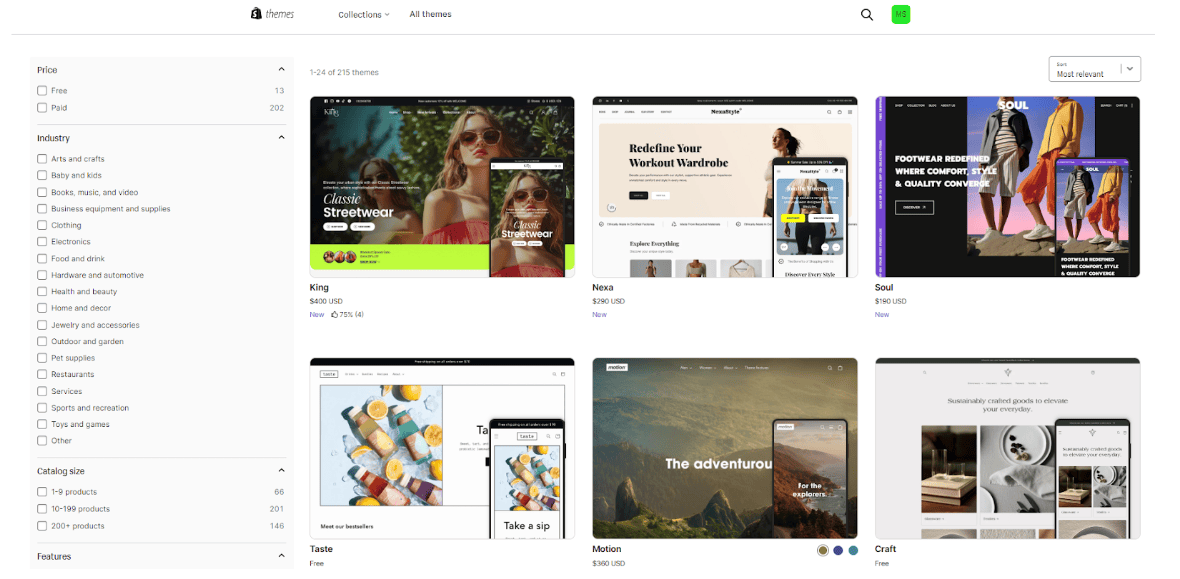
Shopify offers over 202 professionally designed themes, with 13 free options, and the rest are available for a one-time fee ranging from $140 to $400. These themes are optimized for mobile, ensuring a seamless shopping experience for smartphone customers—an essential feature, given the high rate of mobile purchases. With practical features like mega menus, quick views, and stock counters, Shopify's templates are polished, easy to navigate, and ready to use. These templates are especially useful for beginners who want a visually stunning, hassle-free store design.
However, remember that most of Shopify's best themes cost money, but the one-off payment grants you access to a theme that enhances your site's user experience and keeps customers engaged.
Again, you can customize your template using drag-and-drop options, changing the CSS, adding custom CSS, and modifying the code. However, its customization options are more streamlined, less flexible, and limited than WooCommerce.
WooCommerce: Flexibility with Familiar WordPress Themes

Because WooCommerce is built on the same framework as WordPress, you get all the advantages of the open-source nature of the platform. You can dive into the code for deeper customizations, integrate third-party tools, or play around with design elements until you get it right. Here's why WooCommerce is a game-changer:
- Theme Integration: Choose from thousands of WordPress themes to create a store that looks exactly how you envision it. Want to stand out even more? WooCommerce comes with 94 dedicated themes designed specifically for e-commerce.
- Unlimited Customization: Like WordPress, WooCommerce allows you to customize every detail of your store. From layout changes to advanced features, the possibilities are endless. Do you need a specific feature like quick view or stock counters? Simply add a plugin!
- Flexibility: Whether running a small business, managing a large inventory, or launching a unique product line, WooCommerce lets you design a store that fits your needs and scales with your growth.
However, with this flexibility comes a learning curve. WooCommerce's themes are highly customizable but might require extra time and effort to fine-tune. For example, adding specific features may require additional plugins, and tweaking the look and feel might involve learning more about CSS or design integrations.
Final Comparison: Shopify vs WooCommerce Templates And Customization
In terms of design, Shopify wins in simplicity. Its pre-built templates are ready to go, professionally designed, and mobile-optimized, making it ideal for users who want to set up a beautiful store quickly. However, premium themes come at a significant cost.
WooCommerce, on the other hand, offers more design flexibility with access to the massive WordPress theme library, but it requires more effort to customize and integrate additional features. If you want complete control over your store’s look and feel, WooCommerce is a better fit, but for those looking for simplicity and speed, Shopify is the way to go.
Add-ons and Integrations: Shopify vs WooCommerce Shopify is ideal if you're looking for a streamlined, high-quality selection of apps with easy setup. At the same time, WooCommerce offers the freedom to create a fully customized experience with an extensive range of plugins.
Shopify Add-ons and Integrations: Streamlined but Selective
 Shopify offers a robust App Store where you can find hundreds of third-party apps to extend your store’s functionality. From email marketing to SEO optimization and lead generation tools like OptinMonster, the app store has solutions for nearly every business need. However, while Shopify’s selection covers essential areas, the range is smaller compared to WooCommerce, and the process of getting apps listed is more rigorous.
Shopify offers a robust App Store where you can find hundreds of third-party apps to extend your store’s functionality. From email marketing to SEO optimization and lead generation tools like OptinMonster, the app store has solutions for nearly every business need. However, while Shopify’s selection covers essential areas, the range is smaller compared to WooCommerce, and the process of getting apps listed is more rigorous.
With Shopify, many apps offer seamless integration, meaning you don’t need advanced technical skills to get them up and running. However, pricing for paid apps is typically based on monthly subscriptions, which can add to your store’s overall costs. In short, Shopify’s app marketplace is user-friendly and highly curated, ensuring high-quality add-ons but with fewer customization options.
WooCommerce Add-ons and Integrations: Unlimited Customization
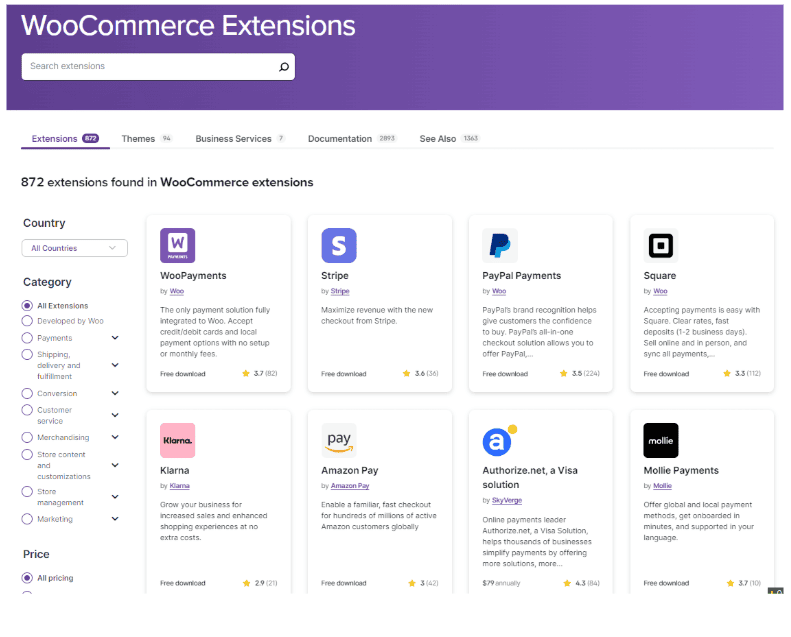 Being an open-source platform built on WordPress, WooCommerce gives you access to over 59,000 free plugins and many more premium options. Again, you will find 872 WooCommerce Extensions and 1363 items. This huge ecosystem allows you to add virtually any feature to your store, from advanced SEO tools like All in One SEO to performance optimization and social media integration plugins.
Being an open-source platform built on WordPress, WooCommerce gives you access to over 59,000 free plugins and many more premium options. Again, you will find 872 WooCommerce Extensions and 1363 items. This huge ecosystem allows you to add virtually any feature to your store, from advanced SEO tools like All in One SEO to performance optimization and social media integration plugins.
WooCommerce also integrates with third-party tools like FunnelKit for one-click upsells and checkout optimization or Advanced Coupons to enhance your coupon offerings.
Because WooCommerce has a lower entry barrier, you'll find more flexibility and a more extensive range of tools than Shopify. Still, it does come with more setup time and potential troubleshooting when using multiple plugins.
Final Comparison: Add-ons and Integration Flexibility
When it comes to add-ons and integrations, Shopify offers a streamlined but more limited range of apps, making it perfect for those who want a simple, all-in-one solution. Its app store guarantees quality but with fewer options for heavy customization, and monthly fees can add up depending on the features you need.
WooCommerce, on the other hand, is the ultimate choice for flexibility and customization. With access to thousands of plugins and integrations, you can build a highly tailored eCommerce store that fits your exact needs. However, managing multiple plugins can require more technical knowledge and hands-on management, making it better suited for users who prefer more control.
SEO & Marketing: Which Platform Gives You a Boost?
Both Shopify and WooCommerce shine in different ways—making this a fair tie depending on what matters most to you. Shopify is your go-to for seamless marketing, while WooCommerce leads the pack in advanced SEO customization. Both platforms are robust, and the choice depends on whether you value marketing ease or SEO flexibility more.
Shopify: Built-In Marketing & SEO Tools for Hassle-Free Growth
If you want to grow your online store with minimal fuss, Shopify has a range of built-in marketing and SEO tools designed to help you. Shopify automatically generates canonical tags and sitemaps, ensuring your site's technical SEO is handled immediately. You can easily edit meta tags, add alt text to your images, and adjust other SEO basics, making it a beginner-friendly platform for improving your search engine rankings.
 For email marketing, Shopify's Shopify Email tool allows you to easily create campaigns, offering drag-and-drop templates and automation to engage your email list. You even get 10,000 free emails per month, with additional emails costing just $1 per 1,000.
For email marketing, Shopify's Shopify Email tool allows you to easily create campaigns, offering drag-and-drop templates and automation to engage your email list. You even get 10,000 free emails per month, with additional emails costing just $1 per 1,000.
When tracking performance, Shopify's robust analytics provide real-time insights into your sales, visitor behavior, and conversions, giving you a clear picture of your business's performance across critical metrics.
WooCommerce: Flexible Marketing, Powerful SEO, but More Setup Required
With WooCommerce, you get much more flexibility in SEO and marketing, but that also means more work on your part. Since WooCommerce is powered by WordPress, you can use powerful SEO plugins like Yoast SEO or Rank Math to optimize your site. It makes WooCommerce ideal for more advanced users who want complete control over their SEO, from adding custom code to tweaking backend settings for optimized site performance.
 WooCommerce doesn't have built-in features for email marketing, so you'll need to rely on plugins. Tools like Mailchimp and MailPoet are free to use and can be easily integrated via plugins. However, it will take longer to set everything up than Shopify's ready-made system.
When it comes to analytics, WooCommerce provides basic e-commerce insights like sales and customer data, but it is less comprehensive than Shopify's. You might have to install extra plugins or use external analytics tools to get a complete view. For instance, WooCommerce offers detailed sales reports and product performance analytics and integrates with tools like Google Analytics for more in-depth insights.
WooCommerce doesn't have built-in features for email marketing, so you'll need to rely on plugins. Tools like Mailchimp and MailPoet are free to use and can be easily integrated via plugins. However, it will take longer to set everything up than Shopify's ready-made system.
When it comes to analytics, WooCommerce provides basic e-commerce insights like sales and customer data, but it is less comprehensive than Shopify's. You might have to install extra plugins or use external analytics tools to get a complete view. For instance, WooCommerce offers detailed sales reports and product performance analytics and integrates with tools like Google Analytics for more in-depth insights.
Final Comparison: Marketing, SEO, and Analytics
Shopify is your friend if you want an all-in-one, user-friendly marketing, SEO, and analytics solution. Everything you need is built into the platform, so you can focus on growing your business without worrying about plugins or technical details. Shopify also excels in email marketing, offering seamless templates and automation, and its analytics provide rich insights for tracking performance. If you want complete control over your SEO and are OK with managing plugins for marketing and analytics, WooCommerce provides the flexibility to tailor your store exactly how you want. However, it requires more time and effort to set up and maintain than Shopify's solutions.
How Secure is Your Store on Shopify vs WooCommerce?
For a secure and hassle-free experience, Shopify is the best option. WooCommerce offers flexibility but requires more responsibility for security.
Shopify: Security That’s Built-In and Easy to Manage
When it comes to protecting your online store, Shopify excels by offering top-tier security measures right out of the box. From the moment you set up your store, Shopify ensures that both you and your customers’ data are safe. Even with the Basic Shopify plan, you’ll benefit from: Default SSL Certificates: Ensures that all website data is encrypted and secure.
- Fraud Analysis Tool: This helps you detect any suspicious activity quickly.
- 2-Factor Authentication: Adds an extra layer of security to your admin access.
- Dedicated Customer Login Areas: Customers can manage their own security settings in one central location.
With all these features built into your Shopify plan, there's little to no extra effort required on your part. Shopify takes care of the technical side, allowing you to focus on running your business without constantly worrying about security.
WooCommerce: Security that needs your responsibility
On the other hand, WooCommerce does provide security measures, but there's more hands-on work involved. You'll need to choose a secure hosting provider. Having secure WooCommerce hosting (like Bluehost, Nexcess, and Pressable) can offer solid additional layers of security to your WooCommerce store. WooCommerce also has 2-factor authentication for admin accounts, but you'll need to install and manage additional security plugins for robust protection. Some popular security plugins for WooCommerce include:
- Jetpack
- Wordfence Security
- MalCare Security Solution
- iThemes Security
- Sucuri Security
- All In One WP Security & Firewall
- Wordfence
While these plugins offer excellent protection, they require time and effort to research, install, and configure. Again, You'll need to actively manage your store's security, which can be time-consuming compared to Shopify's all-in-one solution.
Final Comparison: Shopify vs WooCommerce Security If you prioritize convenience and peace of mind, Shopify is the clear winner regarding security. Its robust, built-in features mean you can rest easy knowing your store is protected without having to dive into technical setup. Shopify handles everything, from SSL certificates to fraud detection, so you can focus on growing your business.
While highly customizable, WooCommerce requires more self-management and research. You'll need to find the right security plugins, secure a reliable host, and stay on top of updates. While WooCommerce offers great flexibility, it demands more responsibility from you to ensure your store is safe from threats.
Shopify vs WooCommerce: Customer Support For first-time users, Shopify offers a seamless, hassle-free journey with plenty of support to help you along the way. It is the better choice for its round-the-clock customer service and centralized resources like the Help Center and Shopify Academy. On the other hand, Woocomerce offers community-driven resources.
Shopify: All-in-One Support and Convenience
If you’re setting up your e-commerce store for the first time, Shopify makes it easy for you with comprehensive, reliable support. Shopify’s customer service is available 24/7 through phone, live chat, email, and social media. Whether you have questions about transaction fees or need help with features, Shopify’s live chat offers quick responses and links to useful resources.
Beyond just support, Shopify’s platform is home to valuable resources like the Shopify Help Center and the Shopify Academy, where you can take interactive courses to enhance your e-commerce skills. With these tools, you’ll never feel lost as you build your store, ensuring smooth sailing at every step of your journey.
WooCommerce: A Community-Driven Approach
WooCommerce, while flexible and powerful, lacks the centralized support system Shopify provides. It offers comprehensive documentation and blog posts, but you’ll often find yourself relying on community forums or YouTube videos from experienced users to solve issues. This DIY approach can be time-consuming, especially when you’re navigating problems with third-party plugins or specific features like product variants. However, WooCommerce's popularity means that there’s no shortage of user-led resources across the web, so you’ll rarely be completely alone. But if you prefer a more hands-on support system, WooCommerce may leave you digging through forums when you're seeking quick answers.
Final Comparison Foe Support: Shopify Vs Woocomerce
When it comes to support, Shopify outshines WooCommerce with its round-the-clock customer service and centralized resources like the Help Center and Shopify Academy. If you prefer a guided experience with easy-to-reach support, Shopify is the better choice.
On the other hand, if you don’t mind relying on community-driven resources and are comfortable with a more DIY approach, WooCommerce gives you the flexibility to shape your store as you see fit—just be prepared for a bit more legwork when it comes to troubleshooting.
What E-commerce Features Fit Your Needs? Shopify or WooCommerce
When choosing between Shopify and WooCommerce, you want the platform that aligns perfectly with your goals. Both platforms excel in different areas, and it's all about matching your needs to their strengths. Let's break down the key features that matter most to you and find out which platform comes out on top:
Customization
- WooCommerce: Are you tech-savvy and love full control? WooCommerce is an open-source playground! You can tweak everything, from page layouts to custom CSS and PHP, making it the ultimate choice if you want to tailor your store exactly how you envision it.
- Shopify: If you're after ease and efficiency, Shopify gives you over 215 customizable themes and lets you modify code with less effort. It's ideal if you prefer a streamlined experience.
Product & Catalog Management
- WooCommerce: Do you need advanced product features like customized attributes, filtering, and reviews? WooCommerce offers more granular control over your catalog.
- **Shopify: **Would you prefer a smoother, more straightforward process? Shopify makes product management effortless with built-in tools and apps that grow with your business.
Order & Inventory Management
- WooCommerce: WooCommerce automates stock tracking and allows backorders, but you might need plugins for advanced inventory features.
- Shopify: Shopify's inventory management is where it shines. With seamless stock updates and multi-site fulfillment, you'll find everything you need built-in, especially for scaling.
Multichannel Selling
- WooCommerce: Want to sell on multiple platforms like Amazon or eBay? WooCommerce can do that through plugins, giving you more flexibility.
- Shopify: Shopify's multichannel setup is already built-in and super easy to use, letting you sell on Facebook, Instagram, and more in just a few clicks.
Payment Gateways
- **WooCommerce: **WooCommerce supports over 80 payment methods, including PayPal, Stripe, and even cryptocurrency. Perfect if you like options.
- Shopify: Shopify Payments removes transaction fees and integrates Apple Pay, Google Pay, and others without third-party apps.
Shipping Methods
- WooCommerce: It offers highly customizable shipping options, including flat rates, free shipping, and integration with major carriers for live rates.
- Shopify: Shopify Shipping integrates discounted shipping rates directly from the admin dashboard and offers up to 88% off shipping with major carriers like USPS and UPS.
Checkout Setup
- WooCommerce: It has highly customizable checkout with guest checkout options and extensions like WooCommerce One-Page Checkout to simplify the process.
- Shopify: Shopify’s one-page checkout and simplified cart abandonment features improve user experience and increase conversions.
Refund Processing
- WooCommerce: It offers manual and automated refund processing, though it depends heavily on the payment gateway’s policies.
- Shopify: Shopify simplifies refunds and has built-in tools to streamline the refund process across multiple channels.
**The Verdict: **
In short, if you want a completely customizable platform where you control every detail, WooCommerce is your best bet. But if simplicity, seamless integrations, and efficient scaling are at the top of your list, Shopify is the way to go. It all comes down to how much control you want vs. how much ease you're after.
Shopify vs WooCommerce: A Side-by-Side Comparison
Here’s a side-by-side comparison of Shopify vs WooCommerce highlighting key fields and their respective winners, So that you can get a final overview at a glance.
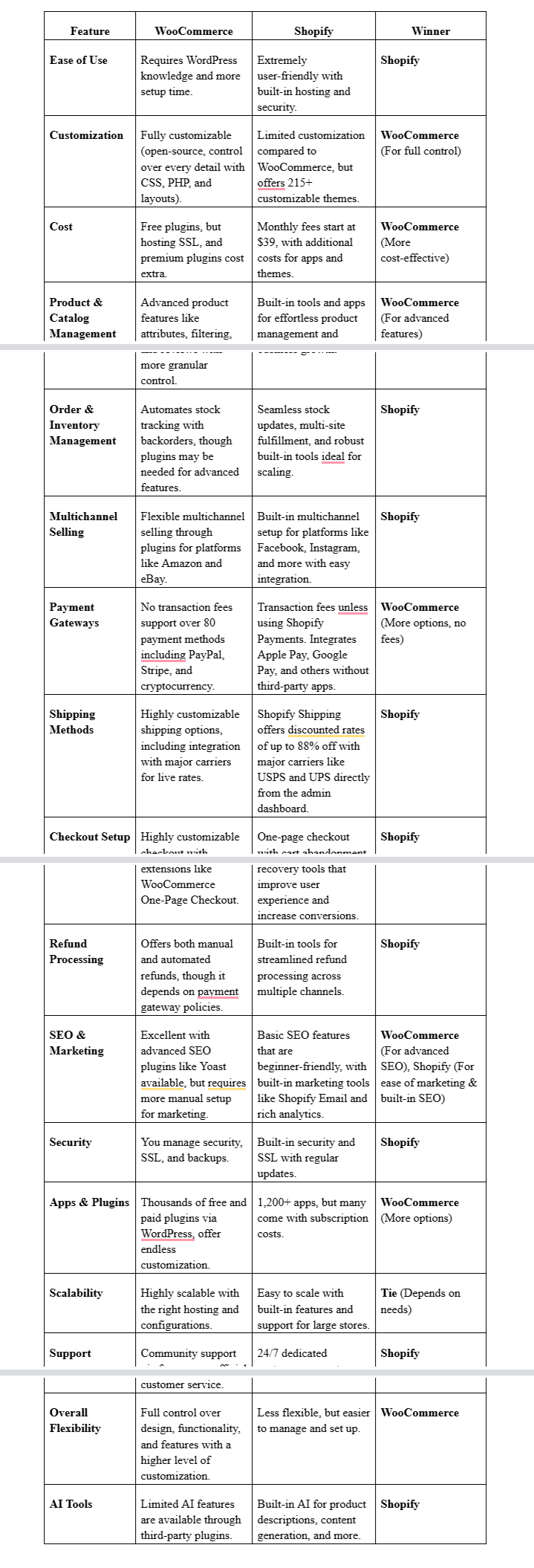
User Stories: Migrating From WooCommerce to Shopify
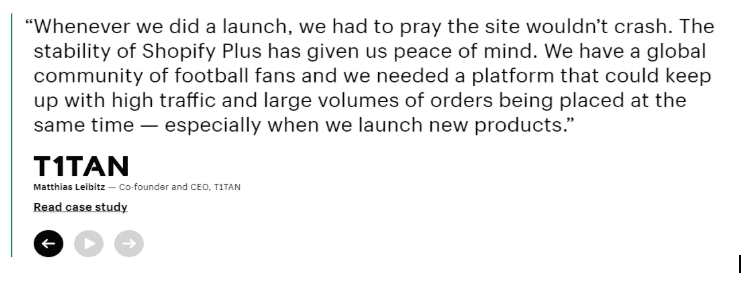 Let’s talk about Matthias Leibitz, co-founder and CEO of T1TAN. His team runs a global football brand, and every time they launched a new product, they used to worry about the site crashing under the pressure of high traffic. But since switching to Shopify Plus, they’ve found peace of mind. The platform’s stability meant that even during major product launches when orders were flying in from all corners of the world, the site stayed strong. That kind of reliability was essential for their business.
Let’s talk about Matthias Leibitz, co-founder and CEO of T1TAN. His team runs a global football brand, and every time they launched a new product, they used to worry about the site crashing under the pressure of high traffic. But since switching to Shopify Plus, they’ve found peace of mind. The platform’s stability meant that even during major product launches when orders were flying in from all corners of the world, the site stayed strong. That kind of reliability was essential for their business.
 On the other hand, Vincent Arrouet, CEO and co-founder of Sunology, faced a different challenge with WordPress. While it offered a lot of customization, the costs for development and project management kept piling up. He realized that these additional expenses would eventually surpass what Shopify was offering in their package. For Vincent, the simplicity and all-in-one approach of Shopify made it a better fit for his growing business.
Both Matthias and Vincent highlight the stability and cost-effectiveness(their thought) that Shopify brings to the table, especially when your business is scaling fast or looking for a reliable platform without hidden development costs.
On the other hand, Vincent Arrouet, CEO and co-founder of Sunology, faced a different challenge with WordPress. While it offered a lot of customization, the costs for development and project management kept piling up. He realized that these additional expenses would eventually surpass what Shopify was offering in their package. For Vincent, the simplicity and all-in-one approach of Shopify made it a better fit for his growing business.
Both Matthias and Vincent highlight the stability and cost-effectiveness(their thought) that Shopify brings to the table, especially when your business is scaling fast or looking for a reliable platform without hidden development costs.
User Stories: Migrating From Shopify to WooCommerce
 Let us tell you about Ava Mutchler from Gardyn. When her team was setting up their online store, they needed something more flexible than the typical cookie-cutter options. That's why they chose WooCommerce—it worked perfectly with WordPress and gave them the creative control they were after. They didn’t want their store to look like everyone else's on Shopify, and WooCommerce allowed them to build something truly unique to their brand.
Let us tell you about Ava Mutchler from Gardyn. When her team was setting up their online store, they needed something more flexible than the typical cookie-cutter options. That's why they chose WooCommerce—it worked perfectly with WordPress and gave them the creative control they were after. They didn’t want their store to look like everyone else's on Shopify, and WooCommerce allowed them to build something truly unique to their brand.

Then there's Shane Barry from Thomp2 Socks. For him, the idea of paying a recurring monthly fee for something as limited as Shopify just didn’t sit right. He wanted the freedom to fully own his site and host it himself, which WooCommerce made possible. He didn’t want the restrictions of a platform like Shopify and valued the ability to customize his store exactly how he envisioned.
Both Ava and Shane highlight what makes WooCommerce stand out—freedom and flexibility. If you’re someone who wants complete control over your site, without being locked into monthly fees, WooCommerce is a path worth exploring!
Our Take on Shopify Vs WooCommerce
If you consider 2024, Shopify's popularity is more than WooCommerce's. People are choosing Shopify for their e-commerce. The main reason for this is its ease of use, scalability, security, support, and advanced e-commerce features. Here, you are pretty sure that Shopify is reducing a lot of your work. It makes you focus on business rather than technical tasks. Many have migrated from WooCommerce to Shopify for all these reasons. But how reasonable is it to depend on a platform for a large business? Your business will be what you want it to be. Each level will have your dominance. You will have to put in a little more effort, though. Your dominance will be such that you will have your opinion at its expense. You don't have to pay for features you don't want. All this WooCommerce will give you. So there are also cases of those who migrated from WooCommerce to Shopify and later returned to WooCommerce.
Ultimately, Shopify's all-in-one solution is perfect for those who want simplicity and support, while WooCommerce is the go-to for those who love customization and control. Both platforms are robust, and your choice depends on whether you value ease or flexibility.
Writing Team:

Nabil Newaz
Lead Developer

Saimul Islam
CEO & Director




